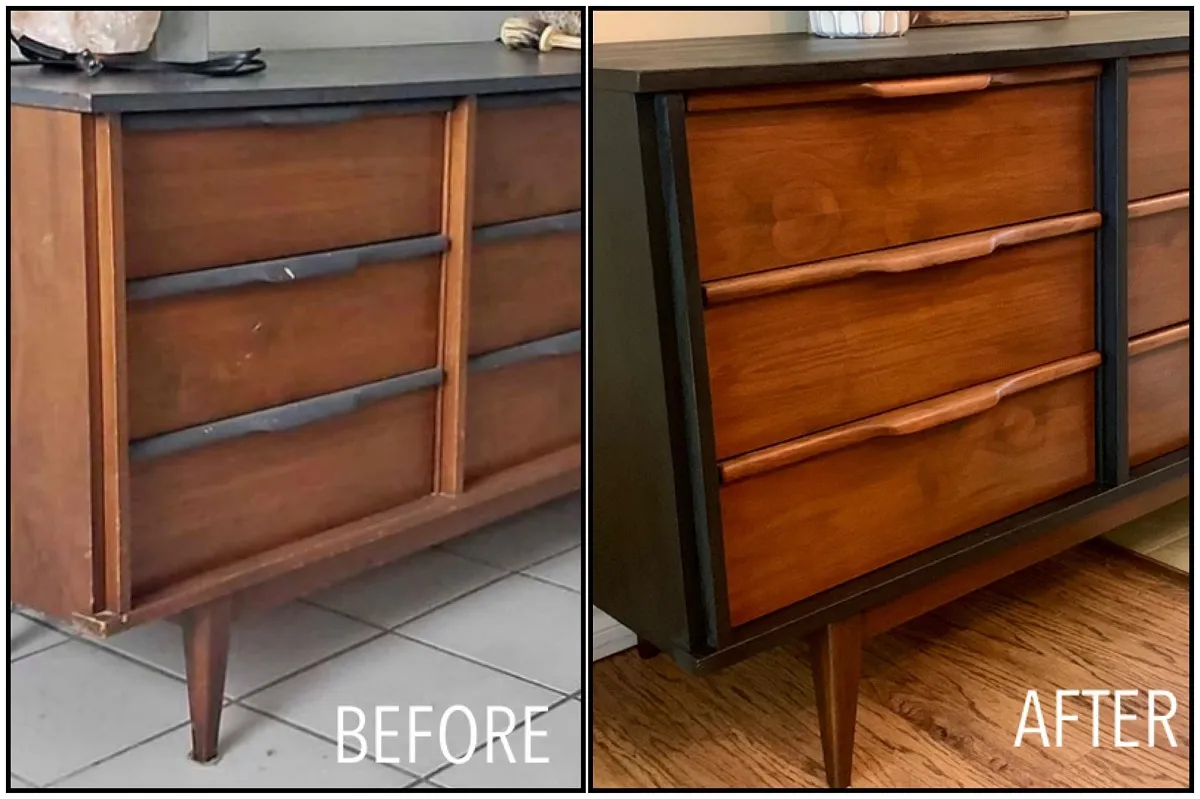Stripping paint from antique furniture is a delicate task that requires precision and care. Proper paint stripping preserves the wood’s quality and maintains the furniture’s value. Antique furniture often has intricate details and unique craftsmanship that can be easily damaged by harsh chemicals or abrasive methods. Using the right techniques ensures that these details are preserved, maintaining the historical and aesthetic value of the piece. Improper stripping can lead to scratches, gouges, and loss of intricate carvings, which not only diminish the beauty of the furniture but also reduce its value.
Preserving the wood quality is paramount. Antique wood has aged and developed a patina that gives it character. Using the wrong methods can strip away this patina, leaving the wood looking new and out of place on an antique piece. By using gentle and appropriate methods, you ensure that the wood’s natural beauty is revealed and enhanced, rather than damaged.
Preparation for Paint Stripping
1. Gathering Materials
Before embarking on your paint-stripping project, gather all the necessary tools and materials. Here’s a comprehensive list to ensure you’re well-prepared:
- Safety Gear: Always prioritize safety by using gloves, goggles, and masks to protect yourself from chemical exposure and fumes.
- Circa 1850 Furniture Stripper: This product is ideal for antique furniture due to its non-flammable, low-odor, and gentle formula.
- Brushes: Use natural bristle brushes to apply the stripper evenly.
- Scrapers and Steel Wool: These tools help remove softened paint without damaging the wood.
- Drop Cloths: Protect your workspace from spills and drips by covering the area with drop cloths.
- Rags and Cleaning Supplies: Keep rags handy for wiping away residue and cleaning the stripped surface.
2. Setting Up Workspace
A well-prepared workspace is crucial for a smooth and safe paint-stripping process. Here are some tips:
- Ventilation: Ensure your workspace is well-ventilated. Even though Circa 1850 Furniture Stripper is low odor, good airflow is essential for safety.
- Protection: Lay down drop cloths to protect floors and surrounding areas from spills.
- Furniture Preparation: Remove any hardware, such as handles or knobs, and if possible, take off any upholstery to prevent damage. Cleaning the furniture beforehand can help the stripper work more effectively by removing dirt and grime.
Choose Circa 1850 Furniture Stripper from The Paint People
Selecting the appropriate paint stripper is vital to protect your antique furniture. There are various types of strippers available, each with its pros and cons:
- Solvent-Based Strippers: Effective but often contain harsh chemicals that can be harmful to wood and the user.
- Caustic Strippers: These are powerful and can remove multiple layers of paint but may damage delicate wood surfaces.
- Biochemical Strippers: Made from natural ingredients, these are safer for both the user and the environment but may require more time to be effective.
For antiques, the Circa 1850 Furniture Stripper is ideal. Here’s why:
- Non-Flammable: Reduces the risk of fire, making it safer to use, especially indoors.
- Low Odor: More pleasant to use in enclosed spaces, reducing the need for excessive ventilation.
- Gentle on Wood: Specifically formulated to be gentle on wood veneers and delicate surfaces, preserving the furniture’s integrity.
By choosing the right stripper, you ensure that the paint removal process is both effective and safe for your antique furniture. The Circa 1850 Furniture Stripper offers a balanced approach, combining effectiveness with safety, making it an excellent choice for restoring antique pieces. You can conveniently purchase this product from The Paint People’s website, ensuring you have the best tools for your restoration project.
Step-by-Step Paint Stripping Guide
1. Applying the Stripper
To begin, apply the Circa 1850 Furniture Stripper generously to the painted surface using a natural bristle brush. Ensure even coverage across the entire area, especially in intricate and detailed sections. The key is to apply a thick layer so the stripper can penetrate through all the paint layers effectively.
2. Waiting Period
Once applied, allow the stripper to sit for the recommended time specified on the product label. Typically, you’ll notice the paint starting to bubble and lift away from the wood. This bubbling indicates that the stripper is working to break down the paint. It’s important to be patient and give the stripper ample time to work, as rushing this process can lead to incomplete removal and additional work later on.
3. Removing Paint
After the waiting period, use a scraper to gently lift the softened paint off the wood. For more detailed or carved areas, use smaller tools like a fine brush or steel wool to avoid damaging the wood. If certain spots are resistant, you may need to reapply the stripper and wait again. Remember to work carefully to preserve the wood’s natural beauty and details.
4. Cleaning the Surface
Once the paint has been removed, it’s crucial to clean the surface thoroughly. Use rags to wipe away any remaining stripper and residue. Steel wool dipped in mineral spirits or another suitable cleaner can help ensure the wood is completely free of any leftover chemicals. This step prepares the surface for refinishing by making sure it’s clean and smooth.
Avoid These Common Mistakes While Stripping Paint
1. Harsh Chemicals
Avoid using harsh chemicals that can damage the wood. Circa 1850 Furniture Stripper is formulated to be gentle on wood, making it a safe choice for antiques.
2. Rushing the Process
Patience is essential. Rushing the stripping process can lead to incomplete removal of paint and potential damage to the wood. Allowing the stripper adequate time to work ensures better results and less effort in the long run.
3. Ignoring Safety Precautions
Always use safety gear, including gloves, goggles, and masks, to protect yourself from chemical exposure. Ensure your workspace is well-ventilated, and follow all safety instructions on the product labels. Ignoring these precautions can lead to health risks and accidents.
By taking your time and following these guidelines, you can effectively strip paint from antique furniture, preserving its beauty and value. For the best results, consider using the Circa 1850 Furniture Stripper, available from The Paint People’s website. This product is specifically designed for delicate tasks like antique furniture restoration, ensuring a safe and effective paint removal process.
Conclusion
Restoring antique furniture through proper paint stripping can be a rewarding and fulfilling project. By following the steps outlined in this guide, you can preserve the integrity and beauty of your antique pieces. Remember the importance of preparation, choosing the right stripper, and taking the necessary safety precautions. With patience and care, your antique furniture can be transformed and given a new lease on life.
The Circa 1850 Furniture Stripper is an excellent choice for this task, combining effectiveness with safety. Available from The Paint People’s website, this product is specifically designed for delicate jobs like antique furniture restoration. Whether you’re a seasoned restorer or a beginner, this guide and the right tools will help you achieve professional results.
Frequently Asked Questions
1. What makes Circa 1850 Furniture Stripper ideal for antique furniture?
Circa 1850 Furniture Stripper is non-flammable, has a low odor, and is gentle on wood veneers and delicate surfaces. These features make it perfect for antique furniture, ensuring effective paint removal without damaging the wood’s integrity.
2. How long should I let the stripper sit before removing the paint?
The waiting period varies, but typically, you should wait until the paint starts to bubble and lift, which usually takes around 15-30 minutes. Always refer to the product’s instructions for specific guidance.
3. Can I use natural methods to strip paint from antiques?
Yes, natural methods like vinegar and baking soda can be used for minor paint removal, but they are less effective than chemical strippers. For fragile antiques, these methods can be useful but may require more time and effort.
4. How do I clean the surface after stripping the paint?
After removing the paint, use rags to wipe away residue and clean the surface with steel wool dipped in mineral spirits or a similar cleaner. This step ensures the wood is free from any remaining chemicals and ready for refinishing.
5. What should I do if the paint doesn’t come off completely?
If some areas remain stubborn, reapply the Circa 1850 Furniture Stripper and wait again before attempting to remove the paint. For intricate details, use a fine brush or steel wool to gently lift the remaining paint.




